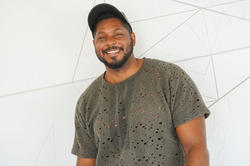A brief interview with one of RISD’s recently hired Schiller Family Assistant Professors in Race in Art and Design.
Red Herrings and Other Delightful Deceptions

Juniors majoring in Painting are considering how contemporary artists address such issues as medium, technology, globalization, colonialism and social justice in a required spring seminar called Global Contemporary Art. Faculty co-leads Elizaveta Shneyderman and Greg Lindquist recently welcomed interdisciplinary artist Andrew Ross into the conversation via Zoom.

“I’m interested in the class’ focus on media,” Ross explained at the opening of his talk, “and more influenced by film history than ‘art history’ per se.”
The Cooper Union grad, who is currently represented by Clima Gallery in Milan and FALSE FLAG in NYC, began making work as a student when YouTube was just starting to make waves. “I responded by making work about objects and authorship,” he says, “including one that incorporated a found piece of plywood pulled out of context called Danger, Do not lean.”


Many of his pieces, Ross says, are intended to feel unfinished in order to put the viewer in a processing mode. “These works feel almost like punchlines,” he adds.
“Cross-sections are a big theme for me,” Ross told students. “I love cutting things out of a hard line and creating the feeling that there’s more outside the frame.”
“I love cutting things out of a hard line and creating the feeling that there’s more outside the frame.”
A series of metal sculptures, including Dining Table and Dining Hall, were inspired by the Hindenburg, whose windows were slanted downward so that passengers could see the ground below. “There is something about the strange vantage points they created that really drew me in,” he says.

Other pieces were inspired by Looney Tunes cartoons and the notion of breaking space, like when Wile E. Coyote draws a hole in the ground for the Road Runner to fall into before being once again outwitted. At the other end of the pop culture spectrum, scientist Neil deGrasse Tyson figures heavily in Ross’ 2017 piece Landowner, which he describes as a kind of “representation of the psyche.”


In terms of medium, Ross notes that he is currently making a lot of work on the computer using rapid prototyping and thus creating renderings rather than physical objects. “There’s a certain unpredictable quality to these pieces,” he says. “I’m not forcing the work to hold as much information as I did in the past. I’ve replaced materiality with simulation.”
One student wondered if Ross is interested in misinterpretation as a device within his work. “Definitely,” Ross responds. “Pieces like Gravity Drawing are about misinterpretation. And Raf’s Thumb is meant to look like a fallen monument but is actually completely apolitical. It’s a red herring whose narrative has been broken.”
—Simone Solondz
April 11, 2022


